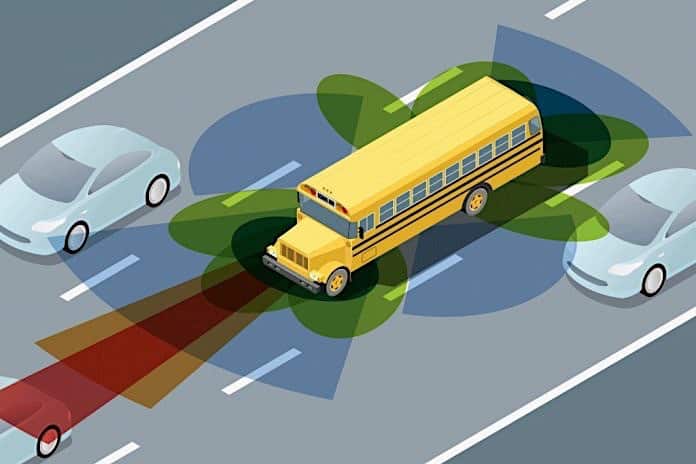Where does the big yellow bus fit into the conversation on smart cars and driverless vehicles? A recent STN webinar dove into the subject in preparation for a general session in July at the STN EXPO.
With giants such as Tesla, Google, and Uber leading the conversation on autonomous vehicles, there is much discussion on what our roads will look like in the future. School Transportation News hosted an hour-long May 25 webinar on how the vehicles some 25 million children ride twice a day fit into the conversation. Fred Andersky is director of governmental and industrial affairs and director of customer solutions for controls at Bendix Commercial Vehicle Systems. He presented on what kind of developments school buses could be seeing in the area of automation.
The number one non-negotiable factor, he said, is that automation and other “smart” functions cannot replace human control in school buses. The driver is still integral to the safety of all involved, and primarily responsible for what happens on the bus. What automation can do, however, is make things safer and easier for the bus driver, students, and nearby vehicles.
After new Driver Assistance Systems (DAS) technology is introduced for cars, it takes about five years for trucks to receive the technology, and another 10 to 15 years for it to trickle down to buses. More complications include the massive size of buses compared to cars, the fact that buses take twice as long to stop as cars do, and the increasingly distracted nature of driving today, as attested by the numerous texting incidents making the news. What might be a minor crash between cars can easily become one including serious injuries or even fatalities when a bus is involved, no matter whose fault it is. Thus, school bus drivers are at a distinct disadvantage compared to other motorists on the road.
Buses, and all vehicles, were originally built to be controlled manually, but automated systems have been added so they can sense danger and act before the driver can, or in case the driver can’t, Andersky said. Stability is the initial stage of bus safety; major improvements have been made by the addition of electronic stability controls so that even if the driver loses control, the bus does not have to tip or roll over.
Collison prevention is the next focus. Video and radar systems should work in unison, he added, to detect nearby objects, alert the driver, or even apply brakes. Future technology is expected to add more “intelligent” features, like making decisions and offering suggestions on following distance and options to brake, giving the bus driver a heads-up and prompting action.
In summary, there many automated functions currently available in passenger vehicles, and some Driver Assistance Systems also available for school buses. In the next five years, Andersky said he anticipates Advanced DAS, complete with more, smarter technology that does some of the work on its own, such as adjusting speed and braking. Past the year 2021, he added that there could be fully automated applications handling everything from stopping if the driver leaves the seat, to parking the empty bus.
Adding new automation technology to buses is a cooperative effort among bus manufacturers, contractors, school districts, governmental agencies and the general public, Andersky concluded. Hurdles exist in the form of cost, regulations, cybersecurity, social acceptance, and reliability. But benefits include a more safe, efficient, eco-friendly, enjoyable ride for both bus drivers and the children they carry, as well as surrounding drivers. On a poll that ran during the webinar, over 70 percent of respondents saw the biggest advantages of driverless school buses to be safer roads or the enabling of the driver to focus more on the kids and their needs. Andersky said that he sees the process of making school buses more autonomous to be an evolution, one that needs to be happening faster.
Editor’s note — School Transportation News will be hosting the STN EXPO Conference and Trade Show in Reno, Nevada from July 7-12, 2017. The general session on Tuesday, July 11 features Thomas Barth, Ph.D., of the National Transportation Safety Board with an update on recent high-profile school bus crash Investigation followed by a roundtable discussion he moderates on Automated School Bus & Crash Mitigation Technology.














